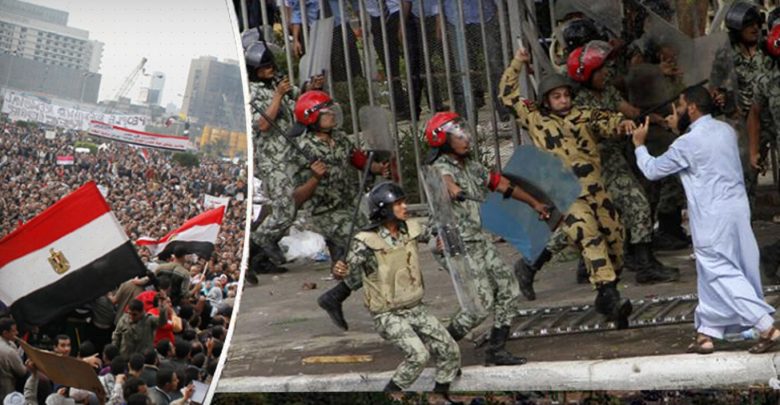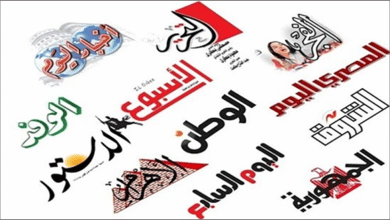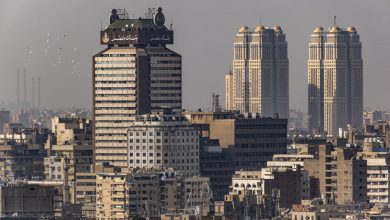
Back to Cairo after 6 years
Whoever stands against general Sisi, here, ends up in jail, or disappears: it is well known. But it’s kinda normal. Today Egypt is somehow off the radar. Research institutes have no recent report on the country. Even the Lonely Planet travel guide is out of stock.
Tourists, analysts, journalists: everybody left.
Returning to Cairo is disheartening. In 2011, the youth of Tahrir Square were a role model for youth from all over the world: even for Americans, who found Arabs a source of inspiration, for once, and in New York occupied Zuccotti Park. Back then, you came here and recharged. There was energy in the air, imagination. Courage. Now Tahrir Square is not even a square anymore. To hamper rallies, it’s been crammed with walls, pillars, the vents of a new underground parking. Barriers of all sorts. From armoured jeeps, snipers guard entrance streets. While a drone guards everything else. Nothing’s left of those moments. Egyptians look at you wearily. And worried about the future. Bad day?, I say to a juice seller. “Bad life,” he says.
And in Sisi’s Cairo, that’s the longest conversation you can hope for. Everybody is scared. Scared not only of rising up: scared of speaking. In 2016, the murder of doctoral student Giulio Regeni, tortured to death for unclear reasons, shocked Italians: but according to Amnesty International, in Egypt three to four Regeni vanish every day. In Egypt, brutality is routine. You walk, and in broad daylight, you happen to see the police beating and dragging away somebody. But you move on. You pretend not to have noticed. “It’s all fine,” I am told by an antique dealer of the old city. “And how else it could go?,” he says. “It’s all fine. It’s all great.”
Outwardly, Cairo looks the same as ever. Over these years, all neighboring countries have deeply changed; the Middle East has a young and growing population, there are cranes and construction sites everywhere: you come back, after three months, six months, one year, and it’s always all so different from your last time that you get lost. Here, instead, it’s all static. It’s all exactly as it was. Hundreds of families still live in the cemetery, while nearby, on the Mokattam hill, Cairo’s dump, the Zabbaleen community still rummage into the garbage, amid a group of French busy taking selfies – because poverty, here, is so chronic to be part and parcel of the landscape: it’s not a social issue, it’s a tourist attraction. There is no trace of public investments. This city has now 18 million people, and still no transport network. Quite often, still no running water. Even though it’s not what it looks like: at all, Cairo is not the same as ever. There is no middle class anymore: out of a 93 million population, not only 27 percent of Egyptians are below the poverty line, but a further 60 percent are just on the brink. While the rich are fewer and fewer, but richer and richer: the newly opened Mall of Egypt has Africa’s first indoor ski resort.
Because Sisi is actually lavishly backed by the Gulf states. Since 2013, Egypt has got more than 50 billion dollars. Its reserves, in the meantime, decreased 31 billion dollars, while its debt increased 21 billion dollars. It’s 102 billion dollars, in all.
Where are they?
And at a closer look, not even the human rights crackdown is actually the same as ever. Because under Mubarak, rules, however fierce, were clear. They were rules. Mubarak controlled the state. Today instead, like Giulio Regeni, you might find yourself in a feud between rival security forces vying for power. And it’s hard to understand if they are all accountable to Sisi: or if, perhaps, they’d like to replace Sisi. Today, in Egypt, the police kills for nothing.
For 3 dollars and 83 cents, for an argument over a taxi ride, as it happened to the driver who got shot dead in February 2016. Or even for less. Even for 40 cents, for an argument over the price of a tea, as it happened to the street vendor who got shot dead in April 2016.
Step by step, law by law, the state’s grip on society has become absolute. Activists were the first to be targeted. Followed by demonstrations, and then by organizations. And on May 29 the new law on NGOs was finally passed. Now NGOs are not only required to register, and to work under the surveillance of a National Authority made up basically by intelligence officers: now every activity must implement state development plans. That is, now every activity must be just a social activity. Not a political activity. And now you need a permit to be on the field, and to publis reports. Or perhaps to publish, generally speaking: there’s no way to read news online, here. Al-Jazeera, the Huffington Post, Mada Masr, which is the main opposition media outlet: it’s all blocked. You get only a blank screen.
Only for activists nothing’s really changed. Their stories, or perhaps, more exactly, their records, are all like Alaa Abd el-Fattah’s, 36 years old, one of the icons of Tahrir square: jailed by Mubarak first, then by the Army, then by Morsi. And now by Sisi.
What’s left is only a city of beggars. With a 30 percent inflation, every single coin is now a little fortune. With the financial crisis of the Gulf states, in fact, Sisi had to borrow 12 billion dollars from the IMF, and the IMF has imposed its usual austerity programs. The Egyptian pound is in freefall: it lost half of its value, a huge blow for a country that relies on imports, especially of food. 94 percent of Egypt is simply sand. And so, it’s true, poverty in Cairo dates back to immemorial times: but in Sisi’s Cairo, what strikes you most are rather those which once were middle class neighborhoods. Zamalek, with its gardens and embassies. Maadi. Heliopolis. The entire city is now an endless plain of crumbling buildings. Tangled cables, flaking plasters, rivulets of sewage. Rutty roads. Flies. Flies everywhere. In Dokki, I ask a man in suit for directions. He shows me the way, we briefly talk: and in the end, he stretches out his hand. Like asking for money. With that distinguished air of a university professor. Sorry, sorry, he says, and he shyly walks away. On the doorstep of his shop, a grocer says: “We are all hungry”.
“Even sugar now is a luxury, here,” he says. “Last fall, the army seized the sugar stocks of a Pepsi plant. But it is in charge of its production and distribution. Warehouses were full,” he says. “They fabricate problems just to convince us that they are the ones who can solve them.”
Then he says: You are a journalist, aren’t you? “Why do you write that this is stability? That the only alternative to Sisi is a disaster? This is the disaster.”
And indeed, while for the outside world the problem, in Egypt, is the divide between the secular and the Islamist camps, the problem here is rather the army. Which is much more than an army: directly or indirectly, it owns two thirds of the economy. And so changing Egypt means changing the army, first: but both camps realized it too late. The left is fragmented. It has brilliant activists, and the support of outstanding writers, film-makers, artists, academics from all fields of study: but everybody speaks just for himself. And the Muslim Brotherhood, which is now again outlaw, is as fragmented as the left. Stigmatized by the West as a hardcore organization, it is actually a gradualist movement that favors social work over political struggle. And that in the end was its flaw: once won the elections, it opted for a compromise: it tried to coexist with the military, rather than challenging it – it was Mohamed Morsi to appoint as Chief of the Armed Forces an obscure marshal named Sisi, a minor officer: that is, apparently, an easy-to-lead officer. The old guard of the Muslim Brotherhood would prefer an agreement with the army even now that it’s been forced underground, and it’s been decimated by trials and life sentences: and the younger generation is calling for deep change, of both leadership and strategy. But it will be a tough process. And most of all, a long process. “And without a leadership, without a plan, nobody will venture into a new revolution,” I am told by a twenty-something at the Pyramids ticket office. “Libya, Syria are just down the corner. Warning you constantly of what you risk,” he says. “In Egypt we are hungry, yes. But we are better than in Aleppo.”
Despite censorship, Egyptians follow carefully the news, and periodically, at every new rally, eventually pre-emptied by a wave of preventive arrests, a new uprising seems to be about to start: but for now, everybody’s priority is making ends meet. For now, everybody curse that 25th of January 2011. I wasn’t in Tahrir, they swear.
And yet, for how long it can go on?
For how long Egyptians will bear such a life?
It’s all of no interest for the world, however. Because Sisi doesn’t do anything for Egyptians, true, but does a lot for all others. To revive the economy, he launched several so called mega-projects: from the Suez canal doubling to a space agency that should discover unspecified resources hidden under the desert. The most famous of these projects is Wadania: the new capital city that will cost 45 billion dollars, “and that Egypt needs like a hole in the head”, in the words of urban planner David Sims. Works of uncertain utility, but certain profit: and foreign investors are all queuing up. Including some 130 Italian companies, led by ENI, Egypt’s main energy producer. It’s running contracts for 16,5 billion dollars: and so, despite Giulio Regeni’s murder, it still views Egypt as “a friendly country”. The murder, it said, didn’t affect investments.
On the brink of bankruptcy, Sisi said he was ready to sell even himself for the sake of his country – and Egyptians took him at his word: he was offered on sale on eBay right away. But it is not only a matter of business, actually. What Sisi really sells is Egypt’s foreign policy. Egypt has the largest, and strongest, Arab army. And that’s already appealing: every year it gets from the United States 1,3 billion dollars of military aid, and among developing countries, it is the first arms buyer. But most of all, Sisi has lined up this army in support to what in 2016 he called “the national armies”. That is, Assad in Syria. Saudi Arabia in Yemen. And even Israel in Gaza: Sisi ordered the flooding of Hamas’ tunnels – used for guns, but also for food. Having no internal legitimacy, Sisi has built a sort of international legitimacy: as the champion of the war on jihadists. Especially in Libya. A country with a 700-mile border with Egypt: and that’s now the supply line of general Haftar, the man the fate of the UN peace plan depends on – as well as the fate of the thousands of migrants who are ready to leave for Europe.
And yet, in his war on terrorism Sisi didn’t achieve so much. Quite the opposite. In Egypt, Islamic extremism is not new. Mubarak faced for many years the jihadists of al-Gama’at al-Islamiyya, that attacked Western tourists. But the Sinai, populated by Bedouins who have always been hostile to the central government, is now a no man’s land: it is now, formally, a province of the Islamic State. And now jihadists strike outside the Sinai, too: they are targeting Copts. That is, Egyptians. Not only foreigners. According to unverified reports, in Syria there are Egyptian special forces, fighting with Assad: but for sure, there are also 3,000 Egyptian jihadists.
Sisi’s Egypt is a desperate Egypt: it is well known. But for us, cinically, Sisi is simply what we need against terrorism. And because that’s why, officially, Tahrir square now is surveilled by drones. That’s why the streets of Cairo are patrolled by snipers in armoured jeeps. The state of emergency, that lasted 30 years under Mubarak, and whose abolition was the symbol of the revolution, now is again in force. Now, again, everybody in Egypt can be detained for any time for any reason. Or also for no reason. And be judged by a military court, with no evidence and no appeal. Now in every metro station there is an explosive scanner.
It’s the only novelty.
The only public investment.
Even though, behind it, policemen sleep. And don’t even see who’s getting in.


